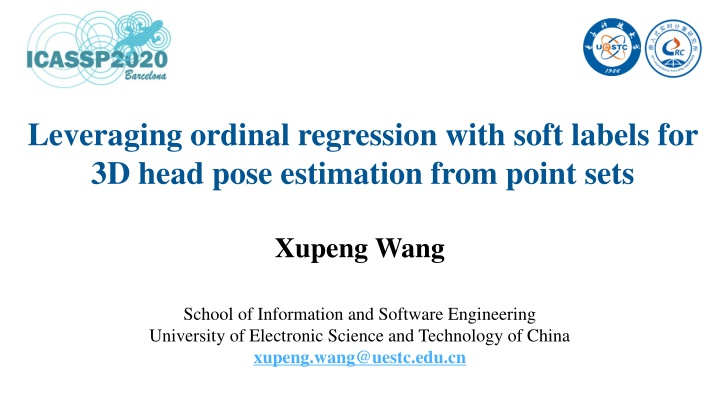
Ordinal Regression for 3D Head Pose Estimation from Point Sets
"Explore how ordinal regression with soft labels enhances 3D head pose estimation using convolutional neural networks on point cloud data. Learn about the advantages, challenges, and solutions in this groundbreaking work by Xupeng Wang."
Download Presentation

Please find below an Image/Link to download the presentation.
The content on the website is provided AS IS for your information and personal use only. It may not be sold, licensed, or shared on other websites without obtaining consent from the author. If you encounter any issues during the download, it is possible that the publisher has removed the file from their server.
You are allowed to download the files provided on this website for personal or commercial use, subject to the condition that they are used lawfully. All files are the property of their respective owners.
The content on the website is provided AS IS for your information and personal use only. It may not be sold, licensed, or shared on other websites without obtaining consent from the author.
E N D
Presentation Transcript
Leveraging ordinal regression with soft labels for 3D head pose estimation from point sets Xupeng Wang School of Information and Software Engineering University of Electronic Science and Technology of China xupeng.wang@uestc.edu.cn
Contents Background 1 Motivation 2 Our work 3 Conclusion 4
Background What is head pose estimation Head pose estimation refers to the analysis of an input image or video, so as to predict the pose information of a head in 3D space. Representation Euler Rotation Angles. Quaternion. ...
Background Robust head pose estimation is a fundamental task for many problems of computer vision and computer graphics, with wide applications in human-machine interaction, VR/AR, driver behavior analysis, and so on.
Contents Background 1 Motivation 2 Our work 3 Conclusion 4
Motivation Deep learning of point cloud becames more and more popular. Popular models: PointNet, PointNet++, PointCNN, PU-Net, etc. What is the advantage of point cloud data? Three dimensional geometry information of target can be obtained. There is no projection transformation from 3D space to 2D imaging plane. Less affected by the change of external light and imaging distance. What is the challenge of point cloud for deep learning Apoint cloud is an unordered set of vectors. Geometric transformations, such as rigid transformation. Non-uniformity density in different areas.
Motivation Our solutions First, we present a convolutional neural network for 3D head pose estimation in an end-to-end manner. Second, to the best of our knowledge, this is the first work to estimate head pose angles from point sets. Third, ordinal regression with soft labels is applied to 3D head pose estimation for the first time.
Contents Background 1 Motivation 2 Our work 3 Conclusion 4
Our Work The network is composed of three modules: Feature Learning Net Ranking Net Prediction Net Feature Learning Net The feature learning net exploits the PointNet++ architecture to extract features from a point cloud. Input data point cloud data (only 3D coordinate information) Output data feature vector
Our Work Ranking Net Hard label In the case of training samples with independent classes, labels can be represented as one-hot vectors.It set the probability of an instance belonging to a class to zero except for the ground truth.
Our Work Soft label In the case of classes with natural orders, the class labels can be cast as probability distributionson the domain. This likelihood can be for mulated by its inter-class distance, that a class closer to the ground truth has a higher probability.
Our Work We use soft label to further improve the performance. Loss of Ranking Net The loss function of the ranking net is defined using cross entropy as follows: rank L
Our Work Prediction Net The prediction net maps the learned feature to the head pose angles by three consecutive fully connected layers. Loss of Prediction Net The L2 loss is utilized by our prediction net and defined as follows pred L
Our Work Total Loss The network is trained in combination with the ordinal regression loss and L2 regression loss. Thus, the overall loss function L is defined as follows: controls the contributions made by the ranking net during the training of the network.
Our Work Experiment Datasets Biwi Head Pose Dataset and Pandora dataset Sample frames from the Pandora dataset. As depicted, extreme poses and challenging camouflage can be present.
Our Work Ablation Study Based on the ablation study, is set to 0.1, and K is set to 5 in the rest of the experiments.
Our Work Quantitative Results The best performance is achieved by the methods based on depth image. The RGB image is a projection from 3D space to 2D image, which loses information important for 3D head pose estimation.
Our Work Quantitative Results As shown in Tab.3, Head PointNet outperforms POSEidon with single inputs on the Pandora Dataset. Furthermore, there is an obvious performance improvement on accuracy exception for the pitch angle, in contrast to POSEidon with complete inputes.
Contents Background 1 Motivation 2 Our Work 3 Conclusion 4
Conclusion A novel deep learning framework is presented for 3D head pose estimation, which extracts features from the point cloud data. A ranking net is deployed to boost the performance, which formulates head pose estimation as the problem of ordinal regression with soft labels. In the further, motion information will be introduced to facilitate the network.






















